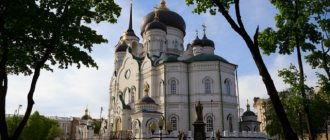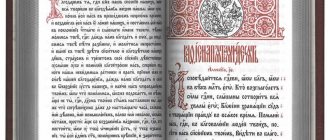Story
Metropolis of Kievan Rus
The question of the time of the founding of the Orthodox metropolis for Rus' is connected with the founding of the first Russian episcopal see. It is usually called Kyiv (see more details). Perhaps already at the end of the century, the Orthodox Church of Constantinople included the Russian Metropolis in the lists of its cathedras. We can speak with greater confidence about the establishment of the All-Russian Metropolis of the Patriarchate of Constantinople along with the Baptism of Rus' under the Holy Grand Duke Vladimir in 988. Probably, although the department was immediately called Kyiv, from the 990s until the completion of the Kyiv St. Sophia Cathedral, founded in 1037, the metropolitans had their seat in Pereyaslav, after which they actually moved into Kyiv.
The jurisdiction of the Kyiv All-Russian Metropolitans included all the lands of the Russian land, newly enlightened by Christ’s teaching. With regard to the internal governance of the Russian Metropolis, the metropolitans were completely independent; their decisions did not require patriarchal approval - primarily due to the remoteness and political independence of Rus' from the Eastern Roman Empire. At the same time, as a rule, metropolitans were elected from natives of the Empire and appointed there. Disputes surrounding the succession to the throne of the All-Russian See often arose due to the fact that the Russian princes sought to install metropolitans who were Russian by birth in Rus', and the Constantinople patriarchs held tightly to the previous order. Thus, on the occasion of the war between Grand Duke Yaroslav and the Empire, the Kiev See was empty for a long time, and in 1051 he ordered the Council of Russian Bishops to install the first Russian Metropolitan, St. Hilarion, blessed by the Patriarch only in retrospect. The election of Clement Smolyatich as Metropolitan in 1147 at the Council of Russian Bishops led to a split between them - those who insisted on the impossibility of installing a Metropolitan without patriarchal participation were initially persecuted, but then received the support of the new Grand Duke Yuri Dolgoruky. Grand Duke Rostislav was forcibly convinced to accept Metropolitan John IV, who was installed in 1164 without his consent, and stated that if the appointment of a metropolitan without his consent was repeated again, then not only would he not be accepted, but a law would be issued “ to elect and install metropolitans from Russians.” by order of the Grand Duke
." However, the opinion [2] that at this time, under the threat of church schism, it was possible to obtain the consent of the Empire to appoint only candidates approved by the prince to the Kyiv Metropolis remains unfounded. Grand Duke Andrei Bogolyubsky made an attempt to divide the Russian metropolis into two, asking the patriarch to appoint Theodore, represented by Prince, as metropolitan of Vladimir, but the patriarch appointed Theodore only as bishop. Thus, the procedure for sending Kyiv metropolitans from the Empire remained unchanged during the pre-Mongol period.
Mongol-Tatar yoke and Western Troubles
Metropolitan Kirill III, elected in Rus' and installed in Constantinople, headed the All-Russian Metropolis for about 40 years until 1281 and established a new order for its existence under the Mongols, firmly rejecting the possibility of union with Roman Catholicism. Metropolitan Kirill called himself “Archbishop of All Rus',” adhering to the concept of his supreme supervision over all the rulers of Rus', who acted by virtue of the powers entrusted by the Metropolitan. The Metropolitan could no longer rule the Russian churches from devastated Kyiv and spent his life on the move, staying the longest in Vladimir-on-Klyazma, and his heir, Saint Maxim, had already finally settled in Vladimir.
The transfer of the metropolitan see to the north prompted the Grand Duke of Galicia, Yuri Lvovich, to ask for the founding of an independent metropolis for his Western Russian lands. The Galician candidate, Saint Peter, was installed not as Metropolitan of Galicia, but of Kyiv and All Rus', and in 1325 he moved to Moscow, where the All-Russian See was finally transferred from Vladimir by his successor, Saint Theognostus. At the same time, subsequent All-Russian metropolitans in Moscow continued to be called Kyiv. At the same time, from the beginning of the 14th century, Western Russian and Lithuanian princes have been trying to divide the Russian flock into eastern and western ones in church terms. Constantinople sometimes appointed Galician and Lithuanian metropolitans, and then again abolished these Western Russian metropolitanates. The stable existence of numerous Russian metropolises did not become established during the Mongol-Tatar period, but this period became a time of inter-jurisdictional church unrest in the Russian flock, reflecting the growing political and cultural disunity of the Russian lands. The separate Lithuanian metropolitanate has been known since the end of the 13th century; the Galician metropolitanate was established three times in the 14th century. Saint Theognostus managed to achieve their closure. In 1352, Metropolitan Theodoret appeared in Kyiv, appointed Patriarch of Tarnovo, but the Council of Constantinople in 1352-1353 deposed him. Although Russian metropolitans were sometimes appointed earlier, the installation of St. Alexius in the Empire in 1354 caused a special council decree that the consecration of a Russian was an exception and for the future All-Russian metropolitans should be appointed from the Greeks. At the same time, it was decided not to divide the Russian metropolitanate, which was soon violated by the will of the Lithuanian Grand Duke Olgerd, who was at enmity with Moscow. The boundaries of the Kiev-Moscow and Kiev-Lithuanian metropolitanates were not demarcated and the rivals interfered in each other's affairs until the death of the Lithuanian Metropolitan Roman in 1362. Despite the resolution of the Council of Constantinople, Patriarch Philotheus of Constantinople yielded to Casimir of Poland and Olgerd of Lithuania, again dividing the Russian metropolis, now into three - in 1371 he installed Anthony as metropolitan in Galich, and in 1376 in Kiev, St. Cyprian. However, the latter, after the death of Saint Alexy of Moscow and the unsuccessful confrontation of the Moscow Grand Dukes for more than ten years, was able to unite the Russian Orthodox flock towards the end of his life. Once again, the question of dividing the Russian metropolis was raised in the 1410s by the Grand Duke Vytautas of Lithuania, who, having been refused in Constantinople, himself assembled a Council of Lithuanian bishops in 1416, which elected Gregory (Tsamblak) Metropolitan of Kiev-Lithuania. By the 1430s, a situation had arisen in which three were elected metropolitans of Kyiv at once - Bishop of Ryazan St. Jonah in the Moscow state, Bishop of Smolensk Gerasim in Lithuania and Isidore in Constantinople. The latter received the appointment, being the instrument of Emperor John Palaiologos to establish a union with Roman Catholicism. Isidore accepted the Union of Florence in 1439, but in 1441, upon returning to Russia, he was condemned by a council of Russian bishops and fled from custody to Rome. After many years of delay, Saint Jonah was installed in Russia without the knowledge of the Uniate Patriarch Gregory Mamma. From that time on, the Metropolis of Kiev and All Rus', with its center in Moscow, no longer resumed its dependence on the Church of Constantinople and from 1461 began to be called Moscow and All Rus'. Its recognition at the universal level, already as an autocephalous Patriarchate, took place in 1590 at the Council of Eastern Hierarchs. For its history, see Russian Orthodox Church.
Metropolis of Southwestern Rus'
The fall of the Eastern Roman Empire, the massive departure of its elites from Orthodoxy, the strengthening of Roman Catholic expansion through Uniateism, the consolidation of the Moscow State and the Polish-Lithuanian Commonwealth - all this led to the collapse of the unity of the Russian Metropolis. In 1458, the former Uniate Patriarch of Constantinople, Gregory, left for Rome and there installed Isidore’s student, the Uniate Gregory, as Metropolitan of Kyiv. Pope Pius II, sending Gregory to King Casimir IV of Poland, assigned 9 dioceses to the metropolis: Bryansk, Smolensk, Przemysl, Turov, Lutsk, Vladimir-Volyn, Polotsk, Kholm and Galicia. With the refusal of the Moscow rulers from the title of Kyiv, only the metropolitans of South-Western Rus' retained it. Metropolitan Gregory was not widely recognized among believers and soon returned to the fold of the Orthodox Church, entering under the Omophorion of Constantinople. The Church of Constantinople could do little to protect the Orthodox in the Polish-Lithuanian Commonwealth, and the subsequent history of the Kyiv Metropolis is a constant struggle to preserve Orthodoxy in the face of Roman Catholic pressure. The see of the Kyiv metropolitans of Southwestern Rus' often moved, defections to the union among the hierarchy were a periodic problem, and relations with the authorities were often hostile. Metropolitan George lived in Lithuania, and his heirs, as a rule, had a residence in Vilna, but Metropolitan Joseph (Soltan) at the beginning of the 16th century lived mostly in Smolensk.
The struggle for the status of Orthodoxy in the Polish-Lithuanian Commonwealth went on with varying degrees of success. In 1509, the Vilna Council tried to achieve greater independence for the Orthodox Church in Lithuania; The judicial privileges of the Russian clergy were confirmed by letters of Prince Alexander in 1499 and King Sigismund I in 1511. In 1522, the Grodno Sejm banned Orthodox Christians from holding senior positions in the state. Metropolitan Onisiphorus (Petrovich the Girl) petitioned Stefan Batory for a charter approving the rights and courts of the Orthodox Church, and from Sigismund III for a charter for church estates. Soon afterwards, the long-prepared cause of the abolition of Orthodoxy in the Polish-Lithuanian Commonwealth was expressed in 1596 in the Union of Brest, which split the ranks of the Orthodox hierarchy.
With the fall of Metropolitan Michael (Rogoza), who accepted the Union of Brest in 1596, the Orthodox Metropolis of Kiev was cut short until it was resumed in 1620 by the Patriarch of Jerusalem Theophan III, who had the authority from the Patriarch of Constantinople to arrange all church affairs in Rus'. Patriarch Theophan appointed Job (Boretsky) and 6 bishops as metropolitan. The Pope ordered the capture and extermination of non-Uniates, and a fierce struggle broke out in the Polish-Lithuanian Commonwealth. The 1629 council for negotiations between the Uniates and the Orthodox was not crowned with success. Only Saint Peter (Mogila) was able to fundamentally improve the position of the Orthodox Church in the Polish-Lithuanian Commonwealth, although due to anti-papist polemics he introduced a number of Roman Catholic cliches into the Orthodox environment. The college he founded became a breeding ground for fighters for the faith and a source of enlightenment for the Orthodox of Little Rus'. In the fight against the union, Peter (Mogila) was helped by the Zaporozhye Cossacks, thanks to whose help, according to the Treaty of Zborov, the Orthodox Metropolitan of Kyiv was given a place in the Sejm along with the Roman Catholic bishops; The Orthodox faith and schools received quite broad privileges. But a significant defeat of the Cossacks was enough for the Orthodox to begin to be persecuted again.
The 1654 treaty on the annexation of Little Russia to Russia did not provide for a revision of the position of the Kyiv Metropolis, and Metropolitan of Kiev Sylvester (Kossov) specifically asked the tsar to maintain the dependence of the Kyiv Metropolis on Constantinople - by that time almost nominal. The next Metropolitan Dionysius (Balaban), having taken the side of the Polish-Lithuanian Commonwealth after the Gayach Treaty of 1658, left Kyiv. In 1659, a new agreement between the Hetman of the Left Bank Yuri Khmelnitsky and Moscow indicated: “ And the Metropolitan of Kiev, and other spiritual minors of Little Russia, should be under the blessing of His Holiness the Patriarch of Moscow
"[3], which began the process of church reunification of South-Western Rus' with North-East Russia. During the period of the Russian-Polish wars and Cossack unrest, the church life of Little Russia also suffered from instability. In 1661, Bishop Maxim (Filimonov) of Mstislav, who was not recognized by the Patriarch of Constantinople, was appointed vicar from Moscow to the Kiev See; in 1663, Dionysius’ protege Joseph (Nelyubovich-Tukalsky), recognized in Constantinople, was elected metropolitan in Chigirin; and the party led by Hetman Teterya elected Bishop Anthony of Przemysl (Vinnitsa) as metropolitan. The turmoil in the church life of Southwestern Rus', caused by strife among the Cossack elders and the devastation of wartime, ended only in 1685-1686. In 1686, the left bank of the Dnieper and Kiev remained forever behind Moscow, in Moscow Gideon Svyatopolk (Prince of Chetvertinsky) was installed as Metropolitan of Kyiv, Galicia and Lesser Russia, and by agreement with the Church of Constantinople, the Kiev Metropolis came under the jurisdiction of the Russian Church. Gideon was given a desk document in which the Kiev Metropolis was named the original among all Russians; she did not obey the Moscow patriarch and was only under his obedience and blessing. The further administrative history of the Kyiv metropolis comes down mainly to the gradual destruction of the features that distinguished it from the Great Russian dioceses.
Monasteries
- Velikoolshansky Bogoroditsky (female)
- Goloseevskaya Pokrovskaya Pustyn (male)
- Gorensky Kiev-Bratsk (female) [17]
- Kyiv Blagoveshchensky in Bortnichi (male)
- Kiev Mother of God-Nativity in the Church (male)
- Kyiv Vvedensky (male)
- Kyiv Voznesensky Florovsky (female)
- Kyiv Desyatinny (male)
- Kyiv Zverinetsky (male)
- Kyiv Panteleimonovsky in Feofaniya (female)
- Kyiv Pokrovsky (women's)
- Kyiv Trinity Ioninsky (male)
- Kitaevskaya Trinity Hermitage (men's)
- Kovalevsky Anastasiinsky (female)
- Neshcherovsky Preobrazhensky (male)
- Tomashovsky Olginsky (female)
- Fasovsky Icon of the Mother of God Hearer (female)
Previously subordinate dioceses
- Mezhigorsky Preobrazhensky (male, now within the Boryspil diocese)
Also on the territory of the diocese is the stauropegial male Kiev-Pechersk Lavra
Device
The ecclesiastical power of the metropolitans extended to all Russian lands, and the metropolitan diocese was also under his direct jurisdiction. At first it was the Kiev diocese itself, and then it had two parts: the Kyiv region and the region around the actual seat of the metropolitans.
At first, after the adoption of Christianity, the appointment of bishops depended entirely on the metropolitans, but in the 12th century the custom was established that the metropolitan only ordains bishops and elects them to the veche. When the appanage-veche order weakened and centralization increased, bishops began to be appointed from the capital, and the role of metropolitans in this appointment became more active, although it was often paralyzed by the power of the princes. Only Novgorod, before the loss of independence, retained the veche election of rulers, who traveled to the cathedral city only for installation. In accordance with the increase or decrease in the role of metropolitans in the appointment of bishops, his power in the dioceses increased or decreased: during the appanage period, when each diocese sought to become independent, metropolitan power was small, but with the fall of appanages it increased.
Under the metropolitan, councils of bishops of the metropolitan area were convened - at them canonical issues were resolved, rules were drawn up, and bishops were judged.
The desk documents constantly stated that the bishops should obey the metropolitan in everything, observe his duties in their diocese, appear at his first call to court or council, call him “father” - for calling the metropolitan “brother” they were reprimanded by him.
Various church incomes went to the benefit of the metropolitan: duties imposed on the installation of bishops; gifts from the newly installed and his diocese; gifts during travel; “entry” from the clergy for the maintenance of the metropolitan along with his retinue during trips. In his diocese, the Metropolitan had many estates, from which he received significant income. Like any bishop, the metropolitan received tribute from all churches in his diocese every year, Peter's and Christmas collections, collections from tithes and other servants and house people.
The court of the metropolitans was modeled after the courts of appanage princes. With him was a whole staff of free servants and people who made up a special army, under the command of a governor appointed by the metropolitan. Every free servant could freely enter the service of the metropolitan, where it was profitable to serve, since the metropolitan servants went to war only when the prince himself mounted a horse. With Vasily Dimitrievich, restrictions begin on the metropolitan’s right to accept free servants into his army, then, as the Moscow state centralizes, metropolitans are deprived of the right to have an army. To manage the metropolis, the metropolitan had secular and ecclesiastical officials: in Kyiv, for example, there were clergy governors; archpriests and archimandrites were entrusted with various judicial and administrative spiritual affairs; tithes dealt with civil litigation of church people and were in charge of collections from the clergy; Volostels were appointed to manage the patrimonial volosts.
The position of the metropolitan in ancient Rus' was very high. Being the spiritual head of all Russian lands, he stood not only at the head of the church hierarchy, but was often the closest adviser to the Grand Duke, and had an important influence on the course of state life. Thus, Saints Peter, Alexy and Jonah did a lot for the elevation of the Moscow prince; During the childhood of the blessed Demetrius of Donskoy, Saint Alexy was in fact the ruler of the state. The Metropolitan often acted as an arbitrator between the princes. Princely letters often began with the words “ with the blessing of our father, the Metropolitan
,” and were also sealed with the metropolitan signature and seal.
Device in Southwestern Rus'
With the division of metropolises, the South-Western dioceses were initially administered by the 9 dioceses listed above from the middle of the century. With the introduction of the Union of Brest, these dioceses were occupied by the Uniates, and although from 1620 Orthodox rulers were again appointed to some, in most cases they did not govern their dioceses. By the time of the Local Council of the Metropolis in 1640, there were seven dioceses operating within it: the Kiev Metropolitan proper, the archdioceses of Polotsk and Smolensk, the bishoprics of Przemysl, Lutsk, Lviv and Mogilev [4]. Since 1686, four dioceses remained under the jurisdiction of Metropolitan Gideon - Galicia, Lvov, Lutsk and Przemysl; but they too were soon converted to the union, after which Gideon remained with the metropolitan diocese itself.
In political life, in the early days of the formation of the Southwestern Metropolis, the metropolitan took a place among the highest officials of the state, but with the introduction of the union, the Orthodox metropolitan lost its importance. In the 17th century, he sought to take a seat in the Senate along with the Roman Catholic metropolitans; this was promised more than once, but was not fulfilled. Metropolitans take part in councils when choosing hetmans, and also participate in the political struggle that took place in Little Russia between the Russian and Polish parties.
With the exception of the stauropegial monasteries and the Chernigov see, the rest of the dioceses and monasteries in the field of administration were subordinate to the metropolitan, who dedicated officials there, judged, etc., sometimes appointing governors for districts, with the right to judge monasteries, churches, their parishioners and subjects on spiritual matters, and sometimes even civil ones. Since the 17th century, under the Kiev Metropolitan, a special cathedral chapter has been mentioned, according to the Roman Catholic model, consisting of the highest spiritual dignitaries of the metropolises; The metropolitan conferred with him and decided on some administrative matters. The will of Gideon (Prince Chetvertinsky) in 1690 mentions consistorists. The cathedral clergy under metropolitans and bishops was called kryloshans.
The sources of support for the Kyiv metropolitans consisted of the ownership of real estate, from court duties, fees for provision, coronal memorials, as well as various fees: canteens - two kopecks from each courtyard, world fees - by money, malt fees - by half a ruble, office fees - by money . The immovable estates of the Kyiv department were formed mainly through grants from state authorities, hetmans and Kyiv colonels; private individuals also donated a lot; The department itself acquired a lot of land by purchase.
Vicar dioceses
- Vicariates of Kyiv:
- Central
- Eastern
- Northern
- South-East
- South
| Kiev diocese on the map of the Kyiv region within the boundaries of 1994-2013. |
Bishops
- St. Michael I (988 - 992)
- Leon (?)
- Theophylact (988 - until 1018)
- John I (before 1018 - ca. 1030)
- Theopempt (1035 - 1040s)
- Cyril I (mentioned 1050)
- St. Hilarion Rusin (1051 - until 1055)
- Ephraim (ca. 1055 - ca. 1065)
- George (ca. 1065 - ca. 1076)
- St. John II (1076/1077 - 1089)
- John III (1090 - 1091)
- Nicholas (mentioned 1097 - 1101)
- Nikephoros I (1104 - 1121)
- Nikita (1122 - 1126)
- Michael II (I) (1130 - 1145/1146)
- Onufry Chernigovsky (1145 - 1147) v/u
- [Dionysius], [Gabriel] [7]
- [Peter ?]
Kyiv metropolitans of the Horde-Lithuanian period
- Cyril III (installed before 1242/1243, ordained ca. 1246/1247, in Rus' mentioned 1250 - 1281)
- St. Maxim (1283 - December 6, 1305) in Kyiv, on his travels, from 1299/1303 in Vladimir-on-Klyazma
- St. Peter (June 1308 - December 21, 1326) in Kyiv, from 1309 in Vladimir-on-Klyazma, from 1325 in Moscow
- ? St. Prokhor (December 1326 - 1328) v/u, bishop. Rostovsky in Moscow
- Michael IV (Mityai) (1378 - 1379) named
(November 15, 1415 - ca. 1420) in Vilna
- St. Jonah (1442/1443 - December 15, 1448) named
- hereinafter referred to as Moscow and All Russia (Russia) (see)
Kyiv Metropolitans of Western Rus' (Kievo-Lithuanian)
- Gregory the Bulgarian (c. 1470 - early 1474)
- Misail (Sokolinsky-Babich) (1474 - 1480)
- Spiridon Satan (September 15, 1475 - ? (+ early 1500s)) was not accepted, spent his life in captivity
- Simeon (mentioned 1481 - 1488)
- Jonah (Glezna) (mentioned 1492)
- Sschmch. Macarius I (1495 - 1497)
- Joseph (Bulgarinovich) (May 30, 1498 - May 1, 1500) v/u
- Joseph (Soltan) (1507 - March 1509) v/u
- Macarius (Muscovite) (March 1, 1534 - April 9, 1535) v/u
1596 - 1620 - fell into union
- Lazar (Baranovich) (1657) locum tenens, bishop. Chernigovsky
- Lazar (Baranovich), 2nd time (1659 - 1661) locum tenens, bishop. Chernigovsky
- Lazar (Baranovich), 3rd time (1679 - 1685) locum tenens, archbishop. Chernigovsky
- St. Theodosius (Polonitsky-Uglitsky) (1679 - 1685) governor of the locum tenens
Geography of deaneries
- Goloseevskoe, First Darnitskoe, Second Darnitskoe, Desnyanskoe, Dneprovskoe, Obolonskoe, Pecherske, Podolske, Svyatoshinskoe, Solomenskoe, First Shevchenkovskoe, Second Shevchenkovskoe, Cemetery, First hospital, Second hospital [16]:
- Kyiv
Borodiansky Vicariate:
- First Borodyanskoe
- Second Borodyanskoe
- Ivankovskoe:
- p. Ivankov
Obukhov Vicariate:
- Obukhovskoe
- Vasilkovskoe
- Grebinkovskoe
- Kalinovskoe
- Ukrainian
- Fastovskoe
Makarov Vicariate:
- Makarovskoe
- Byshevskoe
- Belogorodskoe
- Boyarskoe
- Buchanskoe
- Vishnevskoe
- Irpenskoe
Literature
- Macarius, Met. History of the Russian Church
. - Lokhvitsky, “Essay on church organization in ancient Russia,” Russian Vestnik
, 1857. - Golubinsky, History of the Russian Church
. - Nevolin, Education of management in Russia from John III to Peter the Great
, (
Collected Works
). - Sergeevich, V.I., Russian legal antiquities
, vol. II, no. 2. - Kapterev, Secular bishops' officials in ancient Russia
. - Znamensky, A Guide to Russian Church History
. - Rozanov, History of the Moscow diocesan administration
. - Kedrov, Spiritual regulations in connection with the transformative activities of Peter the Great
. - Suvorov, N. S., Course of Church Law
, Yaroslavl, 1890.






